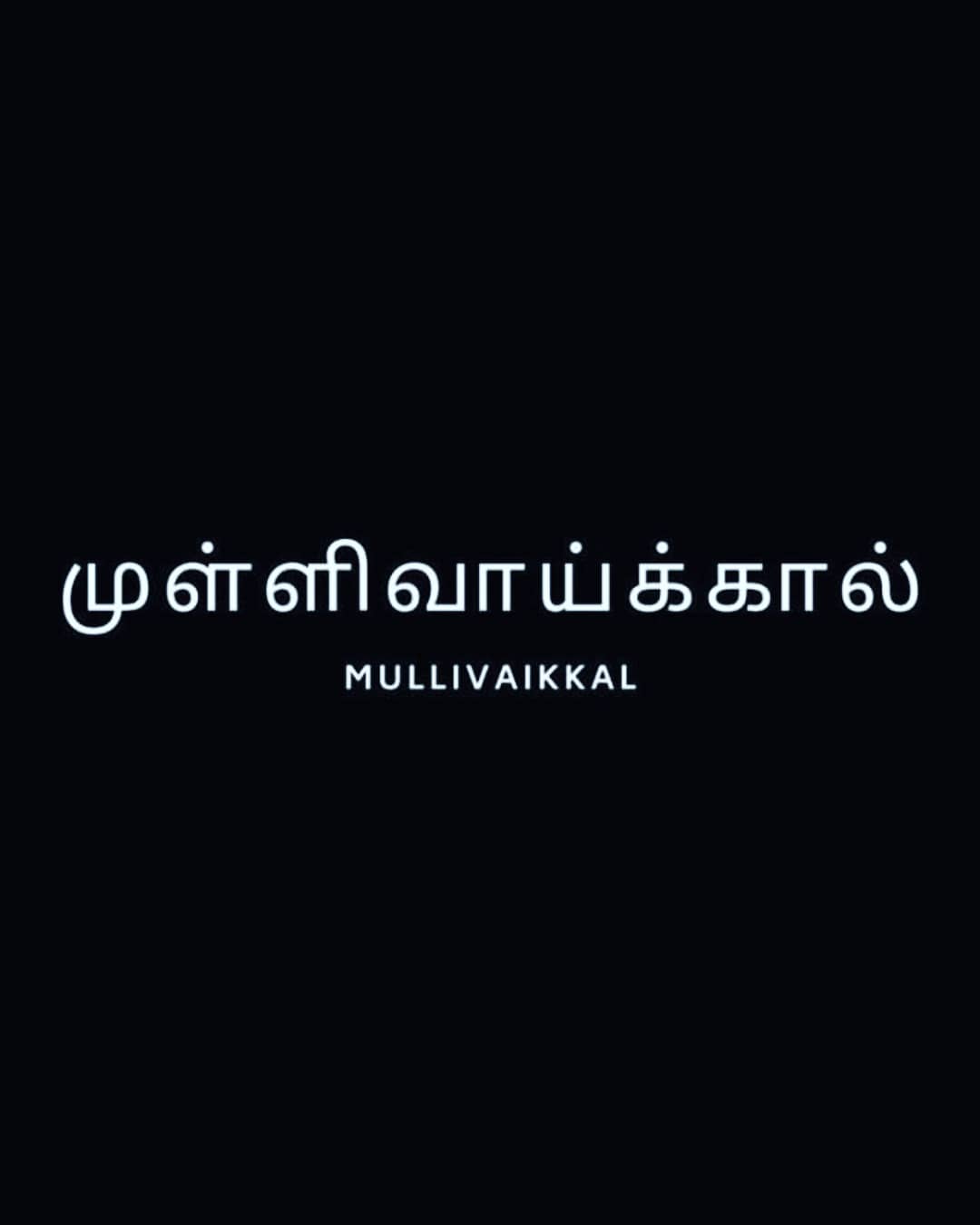
May 18. I still remember that day so clearly, I was 14 years old. My family and I were driving back home from Sydney after a protest. We were in the car. My mother gets a call…all I hear from her conversation is ‘Aiyo’ as she starts crying and screaming. We were all concerned. News broke out. The war had ended.
My entire body was frozen. Without understanding what to say. Three decades of armed struggle. More than three decades of oppression. My entire childhood was centred around learning about Tamils, the war and our people. I didn’t even know any English until after I attended school, which is not common for a child born in an English-speaking nation such as Australia. All those years growing up thinking, that by the time I was an adult, I would get to go home to Eelam and claim it as my country. It’s been 10 years since that day. 10 years since the lives of Eelam Tamil’s were shaken, shattered and broken. Our dreams of an independent state. Our dreams of freedom. Our dreams for the next generation. It is so hard to write about this loss. This loss isn’t digestible. It is as if something has been stuck in my throat for a decade now. Every Maaveerar thinam, every Black July, every Mullivaikkal Remembrance Day. EVERY SINGLE DAY THE THOUGHT OF THE LOSS OCCURS IN MY MIND.
How could this occur? How are we still fighting for basic answers to the war crimes which were committed? How are we still seeking answers regarding the missing Annas and Akkas? How are we still seeking justice? How is oppression still occurring where there is a so called ‘unity’? When you look back in time, you will notice that the war began due to Tamil youth feeling that they could not rely on the government nor the politicians anymore. They felt the need to begin an armed struggle, as they could no longer face oppression and started to realise that the continued oppression will only get worse for future generations. Many of us grew up on the notion and belief of Tamil Eelam. Many of us grew up wishing for an independent state for the Tamil people, a state where there was equality and a place which was home without discrimination.
I ask you, for one moment, let us put the concept of having an independent state in the back burner. Let us focus on the present moment and focus on what is going on now, years later. Let us start by asking this question first; why are we still living in oppression? Why are the Tamil people of Sri Lanka still getting monitored with systematic militarisation? It is one thing to say the war is over, yet why is there systematic militarisation still occurring? Why is there still constant harassment to former cadres and their families throughout the north and eastern provinces? Why?!
So far, I have poured my heart out and spoken about my raw emotions about a time that was a struggle and continues to be to this day. It’s a feeling that is scattered all over and lays in a bed of heartache. I have broken this piece into parts to educate and put my emotions into perspective.
The war
The aftermath
The next step forward
Removal of anger and hatred
Unity
The future generation
The closing paragraph
The War
This part is about why it all started - leading to a bloody, gruesome, lengthy 30-year civil war. Firstly, this was a war which started due to the institutional oppression Tamil people faced from the Sri Lankan government and extremists. Notice how I state the government of Sri Lanka and extremists, because to hate on all Sinhalese people will make us no different from those that committed atrocities towards Tamil people simply based on ethnic differences. Both sides faced a loss and we must first acknowledge that if we want to rebuild. We are against the oppressor not an entire group of people. Now moving onto the facts.
This war started in the 80’s, but the oppression was established long before that, prior to the first president coming into power. This oppression occurred when there was a shift in power and the equally living Sinhalese and Tamils were placed in a position where the majority race was given ruling power. In the hands of power, small changes occurred which caused distrust in the Sri Lankan government and eventually the Sinhala Only Act was brought into play in 1956. This was a major influence in distrust and a major impact to the Tamil people. This was the government saying that the Tamil people were not of the same value. Move forward a few more years and the Sri Lankan flag was officially adopted on December 17, 1978. Prior to 1815, the gold lion was originally the national flag of Ceylon; its four pippul leaves are Buddhist symbols and the sword is said to represent authority. On this modern version, the green represents Muslims, while the orange represents Hindus. Want to know more about the little things on the flag…. just Google it. Please don’t be ignorant. So, let’s be honest just from these two things you can tell there’s a major shift in power and there is definitely a sign of racism. Now skip forward to 1981. The burning of the Jaffna library. Our literature. Our history. Our ancestral information and writings. Then, what about Black July? 1983. Black July. Wow. The black and white images still haunt me and I haven’t even seen them all.
The 1983 riots are what led to the beginning of a 30-year war which saw the loss of countless innocent lives. It sparked a flame which continues to burn to this very day. As a child of an immigrant I grew up seeing our immigrant parents and the difficulty they faced. I grew up seeing and hearing the oppression my Tamil families faced back home. I grew up facing an identity crisis and a struggle of being so privileged that at times I too was ignorant. Once again, I’m rambling my emotions. Let’s go back to the facts. The 1983 riots sparked the war to which there was a back and forth struggle between the Liberation Tigers of Tamil Eelam (LTTE) against the Sri Lankan Government and Sri Lankan Armed forces. A war which led to a multitude of innocent civilians being raped, tortured, discriminated, abused and living in fear. To this day, the rape, torture, discrimination, abuse and living in fear still occurs to Tamil people in the North and East of the country….
The Aftermath
10+ years on.
No answers to the missing people. No answers to the white van kidnappings. No answers to all the questions we ask in regard to justice and war crimes. There is continued militarisation through the North and Eastern provinces. The Tamil provinces of Sri Lanka have been seeing multiple structural and cultural changes with Sinhala based identities being placed. With simple examples of a Buddhist temple being built in Jaffna. Religious logos being written in Sinhalese instead of Tamil. Whether it be a big change or a little change, there is systematic assimilation which occurs to this day.
Let’s break down the aftermath of the war. Firstly, the massacre in the end which led to the death of what is stated officially as 40,000 innocent civilians. Mainly Tamil but Sinhalese also. However, some say the number reaches nearly 140,000 or more. For a second, imagine how many people were injured, lost a limb, were displaced and how many families were ruined by the loss of one or more members. This was the beginning of the aftermath. With no armed resistance, the government started to kidnap and torture multiple Tamils. Anyone they were suspicious of, even without any proof, they would take away and question them, torture them and hold them captive until they pleased. In some cases, victims have stated that they have been held captive for more than 5 years. The officials had a list and documented all the people that they had captured or taken away and yet there is no list being released ten years on and those people are still missing or are presumed dead. Just earlier this year and late last year, various mass grave sights were found with a plethora of bodies from infants to grown adults. There has been a systematic assimilation of Sinhala into the North and Eastern provinces from the military based tourism projects, to building Buddhist temples and even tiny changes like signs in Sinhalese on buses. There has been a systematic militarization of the North and Eastern provinces where the military operate as either military or locals working in military based businesses. Just recently as I write this, the Sri Lankan government are celebrating their so called ‘Independence Day’ by having military parades and parading various weaponry as a sign of power and mass destruction. Independence should be about unity and peace, yet their overall reflection on this matter clearly doesn’t show the same. The aftermath of all the genocide and civil war has left Tamil people in the same place they were prior to the civil war. They are still not treated as equals and they are yet to be given any justice or answers regarding all the people that are missing.
The next step forward
This is probably the most important part and why I began to write this piece. I cannot believe I have been trying to write this for over 5 months now. The present. The current moment. This is where the Tamil diaspora can investigate making a change and empowering our fellow Tamil people, whether it be those in foreign nations or those back home. There are many organizations and individuals in the international community who work towards rehabilitating. I recently read something which really stuck with me. When it comes to those who wonder what they can do for those back home, here is your answer. There are many ways and there isn’t one right thing to do. Knowledge is power and you need to educate yourself. Once you’ve educated yourself, you’ll be able to find out what you can do based on your suitability to help the struggle. There are many activists and organisations out there who are more than happy to help assist and spend their time assisting new activists find their feet. The learning should never stop as there will always be more to learn. Some of us focus on research and advocacy with countries, others focus on strengthening the community within the diaspora, then some choose to build institutions and support the people back home with education and livelihood. There is no one set path you must take when there are multiple options you can use in order to make a change and have an impact. After all it's a ripple effect. Even recently, I was having a discussion with my partner and sister to which I heard this being said; ‘everyone has a role to play’, that is something that resonated so deep within me as it is so true. Those who want to give back and help, all have a role to play, what that role looks like is based on the individual. However, we should not look down upon or segregate those that are trying to help, in a way that suits their lifestyle.
The next step forward is to realise that rebuilding and unity are the core needs. If our actions bring us to that goal, then we have hope in a better future. It gives us the opportunity to focus on rebuilding our communities and uniting our Tamil people together in order to achieve for the greater good.
Anger and hatred
The recent Easter bomb blasts had many Tamil people speaking up and raising awareness regarding the atrocities which happened in 2009 as it was a time when the international media had a spotlight on Sri Lanka, and it was a great opportunity to spark debate and investigation. During this time there was a popular hashtag going around - #prayforthevictims. This was a response to the hashtag of -#prayforsrilanka. It was an interesting time as during this distressing and awful period, many Tamil people raised their voices without bashing any Sinhala people. So, kudos to us. However, I want to touch on two points regarding the topic of anger and hatred. First and foremost, I applaud everyone who genuinely was out there raising their voice for their rights and during that time there were many Sinhala supremacist who chose to attack various activists and threaten them. During that time, it was so upsetting to see our Tamil youth go through and face hatred aimed at them, although what prevailed in the end was adversity as they were supported through it all. It’s amazing to see that through all we faced, even then the concept of anger and hatred was not placed towards Sinhala people but only towards the Sri Lankan government, the Sri Lankan armed forces and Sinhala supremacists. With that being said, what I did see was my own people bash one another since there is a belief that we all should hold the same beliefs and play the same role towards helping back home. It got to the point where people I knew felt uncomfortable speaking up as they felt as if what they did and do with good intentions was interpreted incorrectly. We need to remember that spreading that anger and hatred towards our people who choose to voice their opinions and help in their own manner will not do anything but cause them to show anger and hatred back.
Unity
This is something that truly means the most to me as even today I see so much distance between Tamil people and I truly believe we need more unity. I understand not everyone can get along with everyone though and when I talk about ‘unity’ it comes down to helping those back home. At this present moment, the desire for a De Facto state of Tamil Eelam is not going to occur anytime soon, so what we need to really address is uniting as Tamil people and helping our brothers and sisters out. They deserve it. The Tamil brothers and sisters back home deserve more opportunities to live happy lives. We need to come together and understand that the trauma and pain which each person has endured will be different from one another. We need to accept that pain and understand that trauma affects everyone differently and we must come together to unite and rebuild ourselves and those around us.
The future generation
My biggest concern is the Tamil identity going extinct one day. I even wrote about it a few years ago, with that being said, it will only cease to exist if we do not teach and educate the future generation of what our people went through or if we do not try and make sure that the future generations speak in Tamil and are proud to be Tamil. I see too many kids these days, refusing to learn or speak Tamil, and lacking basic knowledge about what caused the war in the first place. So many people who choose to turn a blind eye when our brothers and sisters back home are still facing injustice. Remember, that could have easily been us or our parents. We are fortunate to live in a foreign nation with all these luxuries when our people back home are still being oppressed. Educate yourself and those around you as that alone will go far in making a change. If you cannot voice your opinions, if you cannot financially contribute, if you cannot advocate for their rights, at least educate yourself and those around you, that way it will spark a conversation and awareness and as that awareness is raised, you will be surprised to see how many people will be inspired. I am speaking from personal experience; the more you educate, the larger we will grow.
The closing paragraph
With all that being said, I stand by a few things. First and foremost, Tamil is such a beautiful language with such a rich culture and heritage. When you do your research, you come to learn that it truly is such a marvel in itself. For instance, growing up I used to wonder and think to myself how stupid it was to have three different mei ezhuthukal to pronounce one sound, yet when you truly explore it, the differences between the ழ, ல and ள are used to distinctly emphasise the sound behind each part in a word. Our language, culture, traditions and the Tamil struggle for freedom are all significant things that make us who we are and which we must continue to emphasise and educate ourselves and one another on. The future of Tamil and Illankai Tamil is in our hands. It is in the hands of the youth and the future generation. So, let’s take a step forward and unite and find avenues to help those in need. There are so many organisations out there and so many individuals, so reach out. If you do not know where to begin, message me, I would be happy to provide you with various options so that you pick something that best suits you. Do what you can, the way you want, so that you are happy and satisfied at the end of the day. Because no matter what, we will forever be united by our Tamil identity.

























